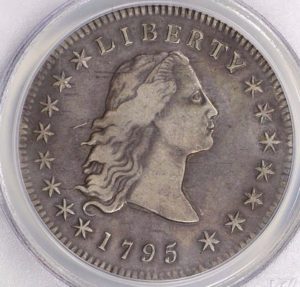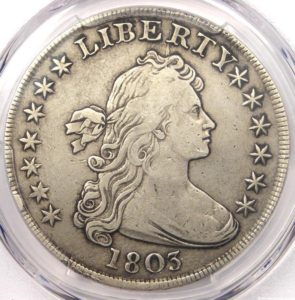Early Silver Dollars – Flowing Hair and Draped Bust Silver Dollars (1794-1804)
Early on, the dollar was decided by Congress to be the cornerstone of the US monetary system. Some of the earliest dollar designs included the Flowing Hair, Capped Bust, and Draped Bust silver dollars. These silver dollars were the foundation of both modern American coins and the  collections of those who are fascinated by them. The first of their kind was the Flowing Hair, which was first minted in 1794 and remains historically important as the first American silver dollar.
collections of those who are fascinated by them. The first of their kind was the Flowing Hair, which was first minted in 1794 and remains historically important as the first American silver dollar.
The Flowing Hair Silver Dollar was designed and engraved by Robert Scot. Scot had been told by his superiors that his design should be “emblematic of Liberty”. Keeping this in mind, the central figure in the Flowing Hair Silver Dollar is a young female with her hair flowing behind her. Above her is the word ‘LIBERTY’, to the sides are the stars of the US states, and below her is the date. On the reverse side of the coin is an eagle perched atop a rock, surrounded by the words ‘UNITED STATES OF AMERICA’. Along the sides of the dollar are the words, ‘HUNDRED CENTS ONE DOLLAR OR UNIT’. Because of its history as the first US dollar as well as its enormous rarity, the Flowing Hair Silver Dollar is highly valued among collectors.
The Draped Bust Silver Dollar can actually be divided into two categories, the Small Eagle (1795-1798) and the Large Eagle (1798-1804). The Small Eagle design was symbolic of America’s growing maturity as a country. Now with a firmly rooted and functioning democracy in place, the government wanted to feature a more respectable design on the US silver dollars. As such, the Small Eagle artwork featured a significantly more mature looking  woman as a successor to the Flowing Hair maiden on the previous dollar. Small Eagles coins are extremely rare and are highly valued among collectors, with particularly high quality variations being extraordinarily difficult to find.
woman as a successor to the Flowing Hair maiden on the previous dollar. Small Eagles coins are extremely rare and are highly valued among collectors, with particularly high quality variations being extraordinarily difficult to find.
Finally, there is the Large Eagle design. The artwork was done by Gilbert Stuart and represented another advancement in the goal of making US currency more mature and respectable. Because of this, the eagle that was seen on the reverse side of the previous dollar was depicted as significantly larger and more grown up. The coin was a symbolic representation of the growing strength and refinement of the American nation and as such the eagle on the reverse side had to represent this change as well.
Due to their extraordinary rarity, Large Eagle Draped Bust Silver Dollars are very valuable to collectors, especially when they are of a higher grade. While grading these coins can be difficult for a variety of reasons, there are still key differences between the quality of different variations of this dollar, making some substantially more valuable than others. This has resulted in many collectors trying to find the best quality Large Eagle variations of the Draped Bust Silver Dollars as they can, with varying degrees of success.
